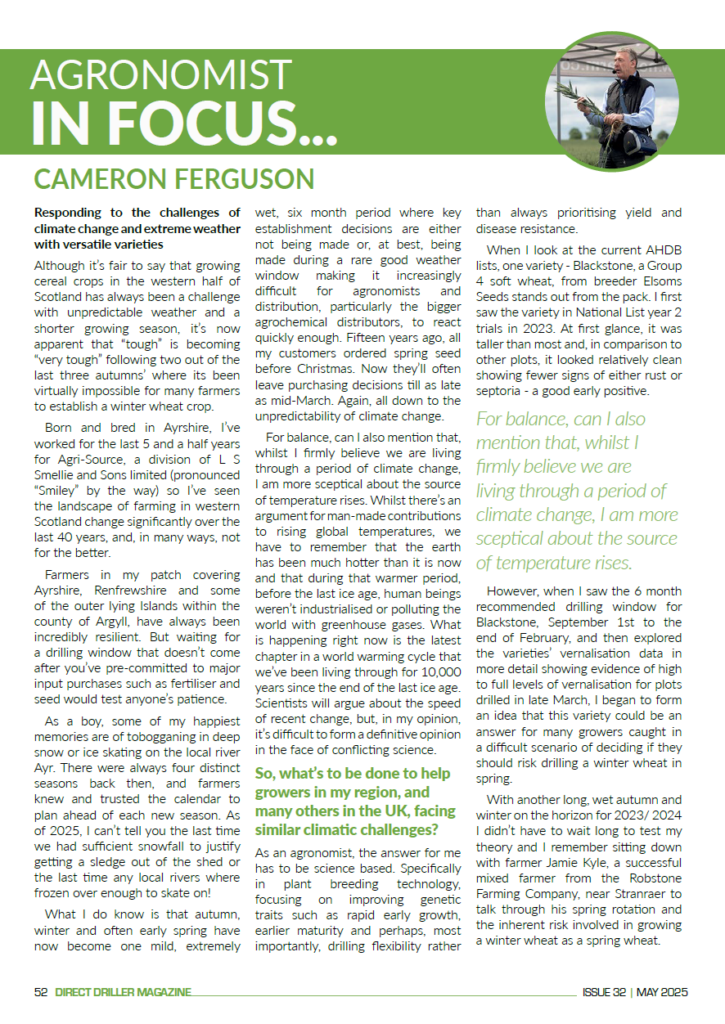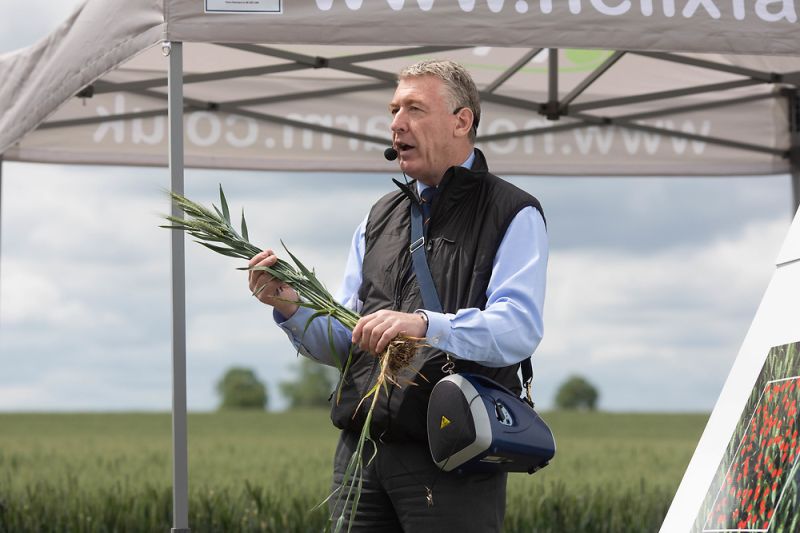Responding to the challenges of climate change and extreme weather with versatile varieties
Although it’s fair to say that growing cereal crops in the western half of Scotland has always been a challenge with unpredictable weather and a shorter growing season, it’s now apparent that “tough” is becoming “very tough” following two out of the last three autumns’ where its been virtually impossible for many farmers to establish a winter wheat crop.
Born and bred in Ayrshire, I’ve worked for the last 5 and a half years for Agri-Source, a division of L S Smellie and Sons limited (pronounced “Smiley” by the way) so I’ve seen the landscape of farming in western Scotland change significantly over the last 40 years, and, in many ways, not for the better.
Farmers in my patch covering Ayrshire, Renfrewshire and some of the outer lying Islands within the county of Argyll, have always been incredibly resilient. But waiting for a drilling window that doesn’t come after you’ve pre-committed to major input purchases such as fertiliser and seed would test anyone’s patience.
As a boy, some of my happiest memories are of tobogganing in deep snow or ice skating on the local river Ayr. There were always four distinct seasons back then, and farmers knew and trusted the calendar to plan ahead of each new season. As of 2025, I can’t tell you the last time we had sufficient snowfall to justify getting a sledge out of the shed or the last time any local rivers where frozen over enough to skate on!
What I do know is that autumn, winter and often early spring have now become one mild, extremely wet, six month period where key establishment decisions are either not being made or, at best, being made during a rare good weather window making it increasingly difficult for agronomists and distribution, particularly the bigger agrochemical distributors, to react quickly enough. Fifteen years ago, all my customers ordered spring seed before Christmas. Now they’ll often leave purchasing decisions till as late as mid-March. Again, all down to the unpredictability of climate change.
For balance, can I also mention that, whilst I firmly believe we are living through a period of climate change, I am more sceptical about the source of temperature rises. Whilst there’s an argument for man-made contributions to rising global temperatures, we have to remember that the earth has been much hotter than it is now and that during that warmer period, before the last ice age, human beings weren’t industrialised or polluting the world with greenhouse gases. What is happening right now is the latest chapter in a world warming cycle that we’ve been living through for 10,000 years since the end of the last ice age. Scientists will argue about the speed of recent change, but, in my opinion, it’s difficult to form a definitive opinion in the face of conflicting science.
So, what’s to be done to help growers in my region, and many others in the UK, facing similar climatic challenges?
As an agronomist, the answer for me has to be science based. Specifically in plant breeding technology, focusing on improving genetic traits such as rapid early growth, earlier maturity and perhaps, most importantly, drilling flexibility rather than always prioritising yield and disease resistance.
When I look at the current AHDB lists, one variety – Blackstone, a Group 4 soft wheat, from breeder Elsoms Seeds stands out from the pack. I first saw the variety in National List year 2 trials in 2023. At first glance, it was taller than most and, in comparison to other plots, it looked relatively clean showing fewer signs of either rust or septoria – a good early positive.
However, when I saw the 6 month recommended drilling window for Blackstone, September 1st to the end of February, and then explored the varieties’ vernalisation data in more detail showing evidence of high to full levels of vernalisation for plots drilled in late March, I began to form an idea that this variety could be an answer for many growers caught in a difficult scenario of deciding if they should risk drilling a winter wheat in spring.
With another long, wet autumn and winter on the horizon for 2023/ 2024 I didn’t have to wait long to test my theory and I remember sitting down with farmer Jamie Kyle, a successful mixed farmer from the Robstone Farming Company, near Stranraer to talk through his spring rotation and the inherent risk involved in growing a winter wheat as a spring wheat.
Whilst I’ve no doubt many agronomists would rightly question my decision given the AHDB official advice and the breeder’s own recommendations, I would like to add that spring seed was very scare in spring 2024, we had the Blackstone seed on farm by late April, it was paid for, plus we’d assessed the vernalisation data supporting the case for Blackstone up to a potential late March drilling slot. The only question remaining in my mind was could Blackstone perform as well, if not better, than bonified spring wheats such as Talisker if drilled in April?
Drilling 10ha of Blackstone at a high seed rate of 400 seeds per m2 on April 28th following a late harvested crop of potatoes the crop got away well, racing through its early growth stages and competing well against the main weed burden of annual meadow grass. On nutrition, 2 main splits of Nitrogen were applied totalling 160kg/ha, and, on fungicides, we went with just a 2 spray program. Spring is a relatively short season in west Scotland, so any septoria present was coming into a growing crop, not waiting to explode since the winter so I believed a 2 spray strategy was justifiable.
Applying the T1 spray on June 12th, we went with 1l/ha of bixafen + prothioconazole + spiroxamine alongside 1l/ha of folpet. This was applied one week after Blackstone had received its second split of Nitrogen and, I have to say, it had tillered well and was looking exceptionally lush. To give it an extra boost we applied 3l/ha of Seamac Gold foliar feed, and, on July 16th, we applied the main T2 ear-spray using the same T1 chemistry but adjusting the dose rates to 1.2l/ha on the bixafen + prothioconazole.
Blackstone stood very well showing no signs of lodging but, despite its height and although it looked quite forward, I felt there was no requirement for a plant growth regulator.
Harvesting on October 3rd, Blackstone combined well achieving a final overall yield of 7.4t/ha at 15% moisture, as good a yield as any spring wheat I’ve grown and a remarkable performance for a winter wheat sown almost 2 months outside its officially recommended drilling window. Jamie Kyle was delighted and will be increasing his area of Blackstone to 16ha for crop25 with a firm eye on the distilling market again with Grant’s distillery on his doorstep.
There’s definitely a need for more varieties with Blackstone’s drilling flexibility and well done to breeder Elsoms Seeds for stepping up with their Responsive Rotations initiative to try to address some of the ever-growing pressures faced in modern day farming. Blackstone is certainly a step in the right direction.


